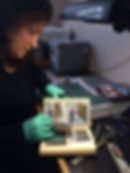Beadwork & Hair at the Petrie Museum
- Ancient Beadwork
- 14 mrt 2017
- 4 minuten om te lezen
Last week, I paid a (research) visit to the Petrie Museum of Egyptian Archaeology in London (http://www.ucl.ac.uk/museums/petrie). If you know the place, I don’t have to tell you about the enormous amount of artifacts this collection houses. It is a wonderful small museum of UCL, and the displays are fantastic as well. If ever in London, you should definitely pay it a visit. I went there to look at the hair samples and the beadwork in the collection.

It’s not often that, as an archaeologist specialized in ancient Egypt, you get to work in a museum dedicated solely to Egyptian archaeology. So you can imagine the Petrie Museum is a real treat, with its beautiful old wooden display cases and cupboards, filled with an impressive 80.000 artefacts collected from excavations in the Nile Valley. It is one of the largest archaeological collections in the world for Egypt and Sudan, named after the archaeologist William Matthew Flinders Petrie (1853-1942). Over three-quarters of the artefacts came from his excavations or were purchased by Petrie. One of the main strengths of the museum collection, by the way, is its focus on ancient dress and costume. It is, for instance, the present-day home of the oldest known surviving dress in the world. All the more reason for us to go and study ancient Egyptian wearable heritage there. I looked at a few dozen objects in the time I spent there. The museum holds very rare beadwork objects still preserved on the original string that were of special interest to me for studying ancient beading techniques. Also in the collection are several well-preserved hair samples and coiffures from different periods of Egyptian history. This may prove a useful addition to my ongoing research on ancient hairstyles from the Amarna Period (14th Century BC) in Egypt.

So let me treat you to a small summary of the results. You should imagine that beadwork was a method commonly used to decorate objects in this ancient culture. Archaeologists have excavated pottery decorated with beads, clothes, mummy nets, jewelry, headdresses, hassocks, sandals and much more. All 18 items of beadwork I looked at during my stay at the Petrie were preserved on the original string on which they were threaded more than 3.000 years ago. Many of the objects were found in the vicinity of the ancient temples and tombs near the ancient city of Thebes, present day Luxor (Egypt). Some of the objects showed beading techniques commonly used in ancient Egypt for decorating objects, but some also displayed very rare techniques I have never seen before! I have been studying Egyptian beadwork for over two decades and it is very exciting to finally hold an object made with a newly attested technique. I guess all objects I looked at were part of costume, dress or jewelry items. Other objects I had a look at were ancient Egyptian amulets such as the ones seen below. This image is a very detailed photograph of an Egyptian faience amulet depicting the god Thoth strung on a small string only 3 mm thick. The amulet itself is just over 2 cm. In the background on the right you can see a textile amulet container on a string with small knots. The latter one was probably worn around the neck. What the amulet contains, remains a mystery to this day...

Amongst the 30 hair samples I looked at, I discovered different types of extensions, hairpieces, small braids and twined hair. The ancient Egyptians didn’t only wear elaborate hairstyles braided into their own hair, they often wore numerous extensions and sometimes very elaborate wigs. Although the latter were probably reserved for the very rich. Many of the Petrie hair samples were much more delicate than I expected. A sample of very delicately matted hair with the extensions still attached to it was discovered in the Petrie collection. This object was most likely part of a hairpiece from the pharaonic period. The techniques used in making this hairpieces were very intricate and I have not seen them before in the Amarna samples. Most of the hair samples are not on permanent display in the museum, but they will be published in the near future. The last image posted here (below) shows a false head ornament from the Roman Period, with small bronze pins keeping its fake braids in place. All the hair pieces I looked at are marvelous examples of the diversity and the importance of hairstyles in ancient Egypt. In Egypt, the way you wore your hair was not a matter of fashion. In this ancient culture, hairstyle showed gender and status, but it also displayed political and social significance.

Anyhow, the results of my research in the Petrie will be published in the near future and I will definitely keep you posted on its progress. By the way, if you want to have a look at the collection yourself, you can do so online: http://petriecat.museums.ucl.ac.uk/.... Enjoy!










